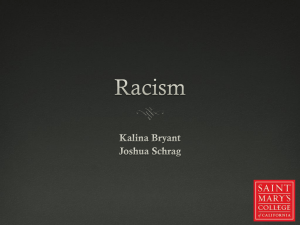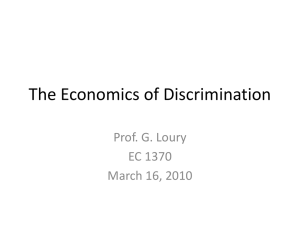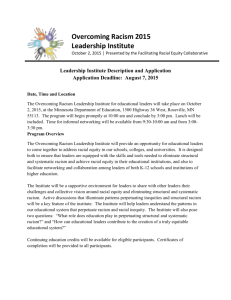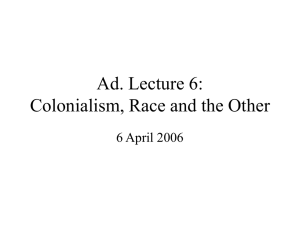Racial Identity Model for People of Color
advertisement
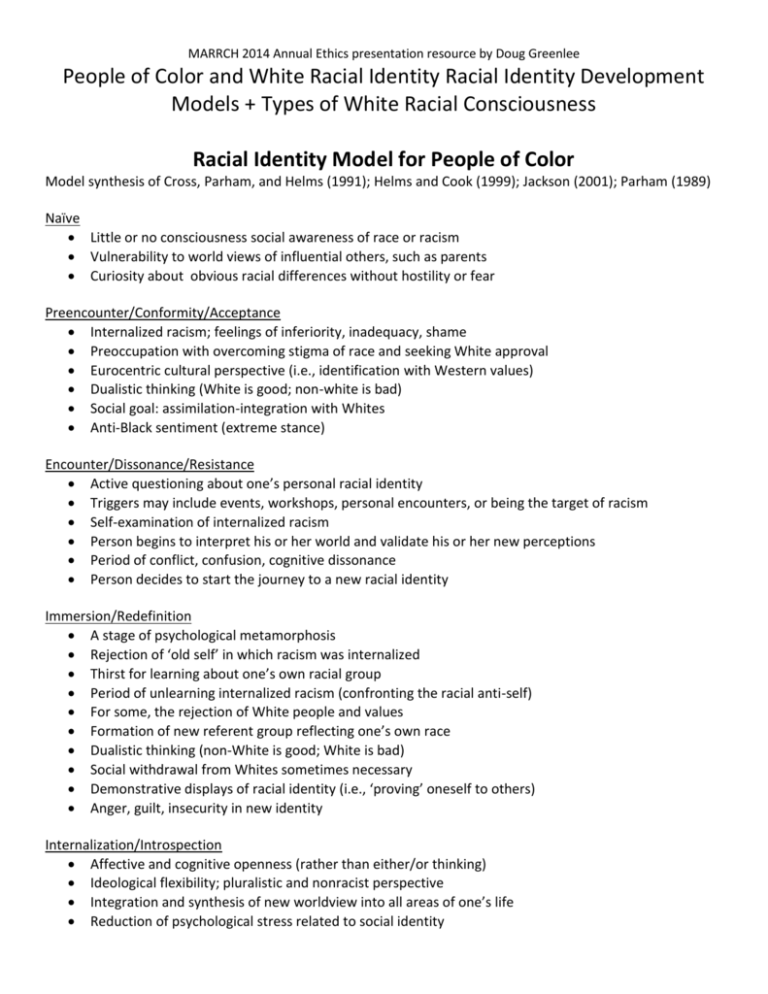
MARRCH 2014 Annual Ethics presentation resource by Doug Greenlee People of Color and White Racial Identity Racial Identity Development Models + Types of White Racial Consciousness Racial Identity Model for People of Color Model synthesis of Cross, Parham, and Helms (1991); Helms and Cook (1999); Jackson (2001); Parham (1989) Naïve Little or no consciousness social awareness of race or racism Vulnerability to world views of influential others, such as parents Curiosity about obvious racial differences without hostility or fear Preencounter/Conformity/Acceptance Internalized racism; feelings of inferiority, inadequacy, shame Preoccupation with overcoming stigma of race and seeking White approval Eurocentric cultural perspective (i.e., identification with Western values) Dualistic thinking (White is good; non-white is bad) Social goal: assimilation-integration with Whites Anti-Black sentiment (extreme stance) Encounter/Dissonance/Resistance Active questioning about one’s personal racial identity Triggers may include events, workshops, personal encounters, or being the target of racism Self-examination of internalized racism Person begins to interpret his or her world and validate his or her new perceptions Period of conflict, confusion, cognitive dissonance Person decides to start the journey to a new racial identity Immersion/Redefinition A stage of psychological metamorphosis Rejection of ‘old self’ in which racism was internalized Thirst for learning about one’s own racial group Period of unlearning internalized racism (confronting the racial anti-self) For some, the rejection of White people and values Formation of new referent group reflecting one’s own race Dualistic thinking (non-White is good; White is bad) Social withdrawal from Whites sometimes necessary Demonstrative displays of racial identity (i.e., ‘proving’ oneself to others) Anger, guilt, insecurity in new identity Internalization/Introspection Affective and cognitive openness (rather than either/or thinking) Ideological flexibility; pluralistic and nonracist perspective Integration and synthesis of new worldview into all areas of one’s life Reduction of psychological stress related to social identity Self-confidence Concern with ethnocentric basis of judging others Critical, complex thinking about self and others Resolution of conflicts between old and new identities Commitment/Integrative Awareness Action toward social change Source: Pack-Brown & Williams, Ethics in a Multicultural Context, pp.159-60. White Racial Identity Developmental Model Synthesis of Hardiman (2001) and Helms and Cook (1999) Naïve Chronologically, up to 5 years old Innocent curiosity about racial differences Seeing racial differences without negative evaluation Acceptance/Contact Learning cultural evaluations about racial difference (begins around age 3) Accepting ‘Whiteness’ as normative: ‘Others’ (i.e., people of color) have differences; ‘we’ (i.e., Whites) don’t Absorbing the cultural myths about race (e.g., who is beautiful, dangerous, smart, or lazy) In its active form: expressing racial hatred, belonging to hate group, engaging in hate crimes, etc. )small percentage of population) In its passive form: not confronting racism Denial of racism, defensiveness (‘I’m not racist’) Resistance/Disintegration Triggered via personal encounter, confusing moral dilemmas regarding racial disparities, enlightenment through education, etc. Questioning and challenging racism Uncertainty about how to relate to people of color (e.g., overly friendly, color-blind, color-conscious) Examination of White privilege and own participation in racism Examination of unconscious internalization of White norms (e.g., paternalism, ‘Let me help you’) Isolation from other Whites (sometimes due to not fitting in anymore, being ostracized, feeling more enlightened than other Whites) ‘Change-back’ pressure from other Whites (difficulty maintaining new awareness; need contact and support from other like-minded Whites) Easy to revert back to acceptance (Both Hardiman and Helms contend that most Whites cannot tolerate the sense of estrangement from other Whites associated with this stage) Anger, self-blame, guilt (you ‘see and know too much’) Reintegration (Helms & Cook) Process of mitigating the anxiety of the disintegrating stage Reduction of cognitive dissonance by conforming to surrounding social standards with regard to race Selective perception and distortion of information Pseudo-Independence (Helms & Cook) Identification with non-racist Whites Being racist seen as being a ‘bad’ person Belief that people of color who conform to White standards are better, more competent, or less threatening Redefinition/Immersion Learning about one’s White ethnic background Redefining one’s relationship with other White’s and with people of color Reading autobiographies of others who have made the same journey Involvement in antiracism training Connecting with other Whites on same journey Separating being White from being racist (establishing a non-racist White identity) New world view becomes part of one’s every role Mission is no longer to ‘save’ people of color, but to understand ‘Whites’ (i.e., the redirection of energy toward self rather than helping others) Sorting out issues around being in a socially constructed ‘superior’ group Empathy rather than defensiveness regarding the anger felt by many people of color toward Whites Proactive stance against racism, yet picking your battles Understanding that White norms are but one set among many Internalization/Autonomy Clear self-interest in challenging racism and White Privilege Understanding connections among ‘isms’ Cultural and racial identity continue to be explored and understood Development of multicultural interpersonal connections Cognitive flexibility in viewing oneself and others regard to racism Source: Pack-Brown & Williams, Ethics in a Multicultural Context, pp. 161-2. Types of White Racial Consciousness Avoidant Dismisses racial issues as irrelevant. Issues concerning people of color are not viewed as affecting one’s day-to-day life. Little to no consciousness about how race shapes one’s life experience as a White person. Dependent Adopts the thinking of influential others. Beliefs that people of color are absorbed from one’s social context. Little independent thinking operate at this stage. Dissonant Is confused and ambivalent about minority issues. Politically correct statements may be made without much conviction. Attempts are made to find answers to troubling questions about racial disparities. Dominative Feels a sense of entitlement and racial privilege. Negative evaluation and/or overt belittling of the cultures and customs of people of color. Belief in the superiority of white values. Conflictive Supports equality. Belief in equal opportunity as long as minorities are not too demanding. Sees affirmative action as creating unfair advantages for people of color. Integrative Values cultural pluralism. Believes in racial and cultural integration. Race and culture do not negatively affect one’s choice of colleagues, friends, and other acquaintances. Reactive Exhibits consciousness about racism at al levels: personal, interpersonal, institutional, and cultural. Believes in processes and procedures that ensure equal access for persons of color in social, political, and economic arenas. May be unconsciously paternalistic to people of color. Source: Pack-Brown & Williams, Ethics in a Multicultural Context, pp. 163.

